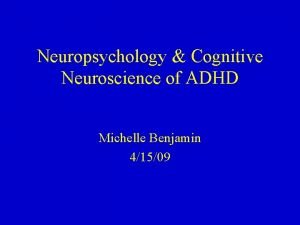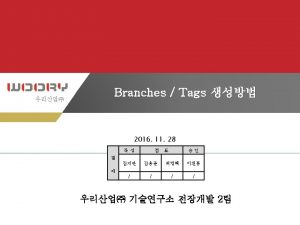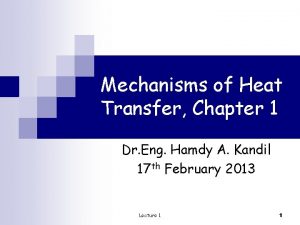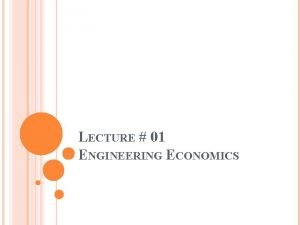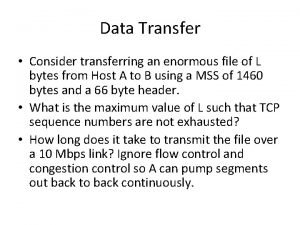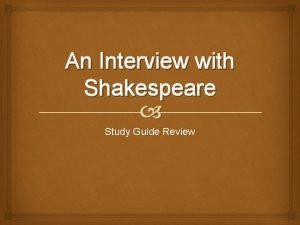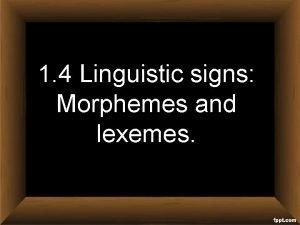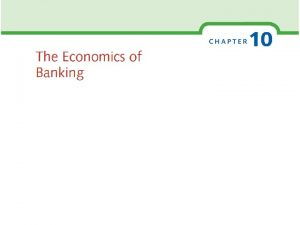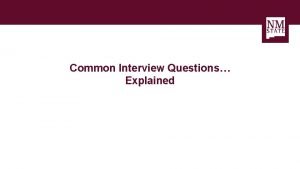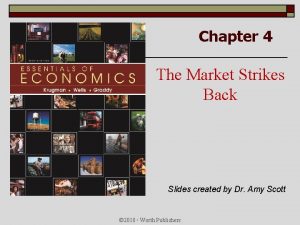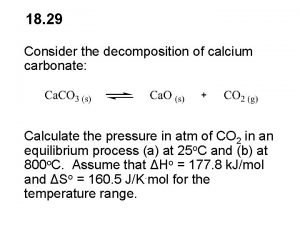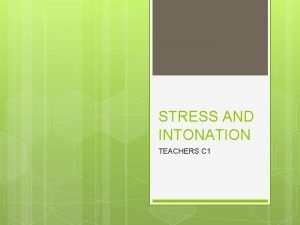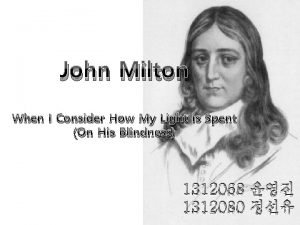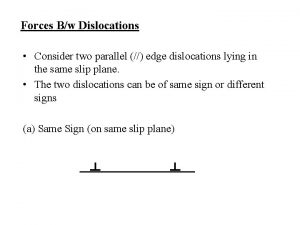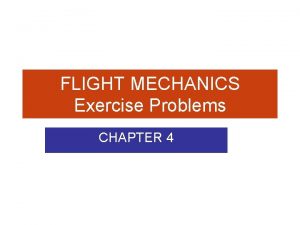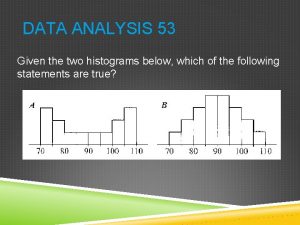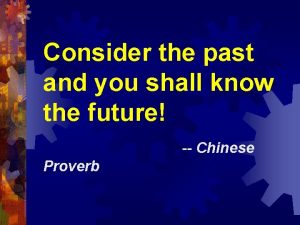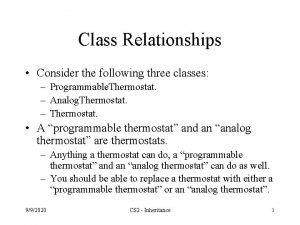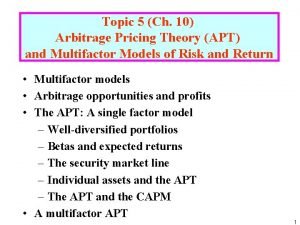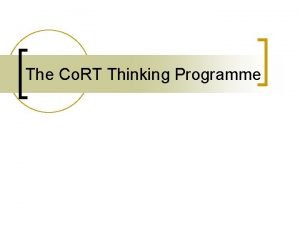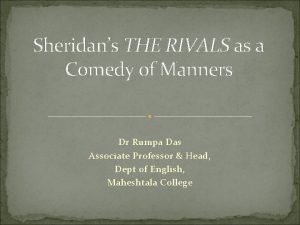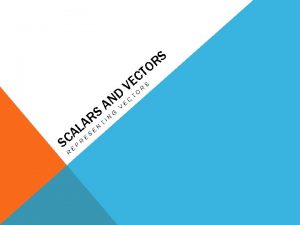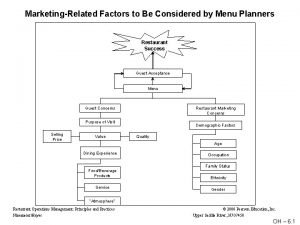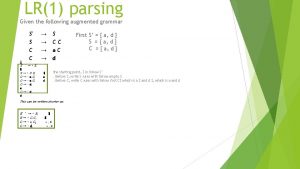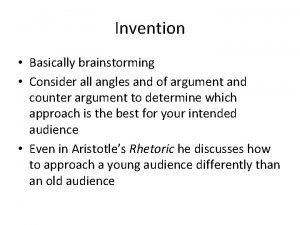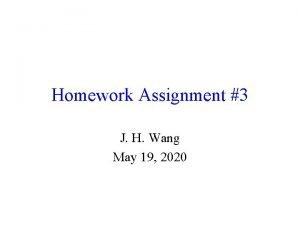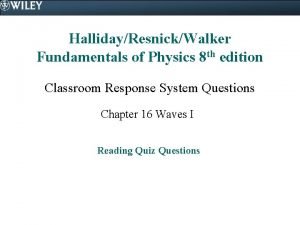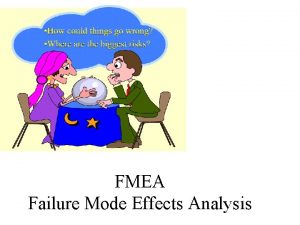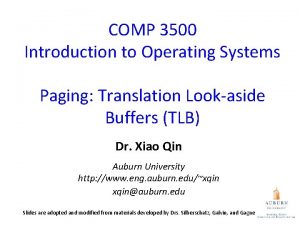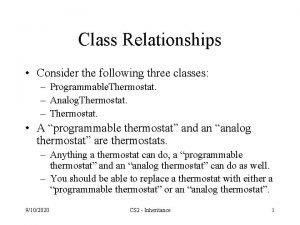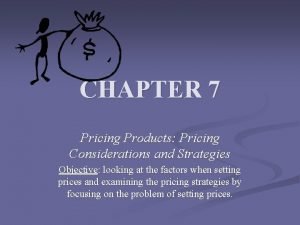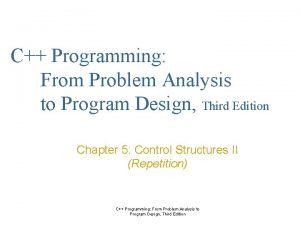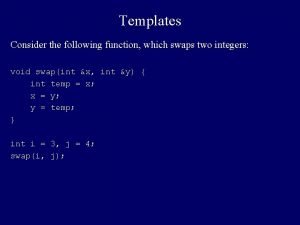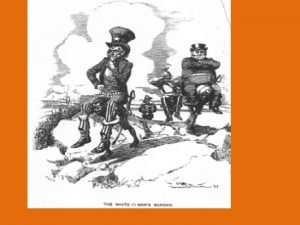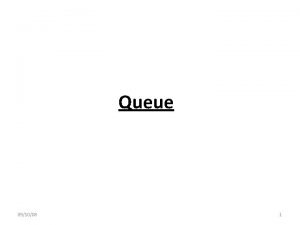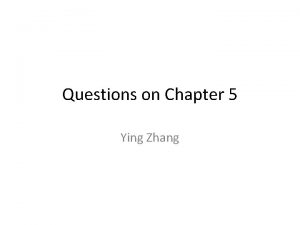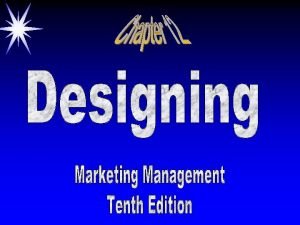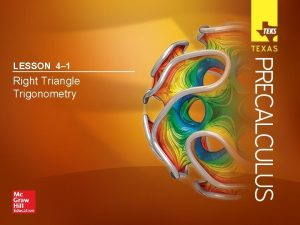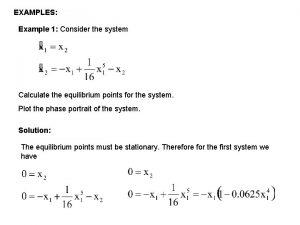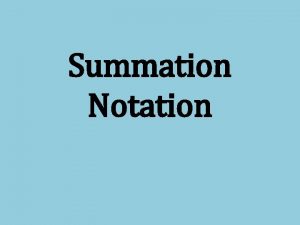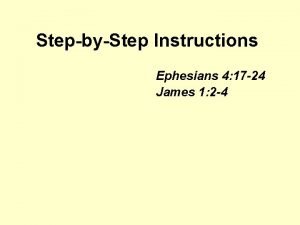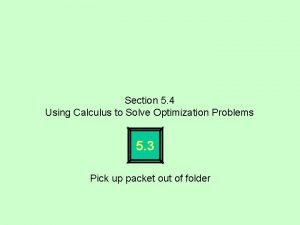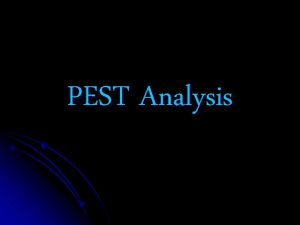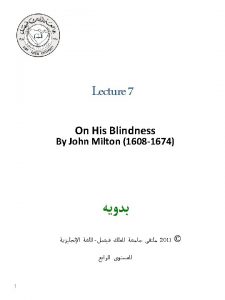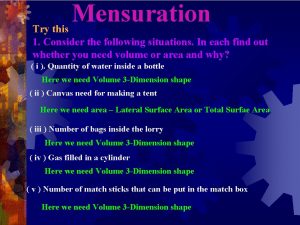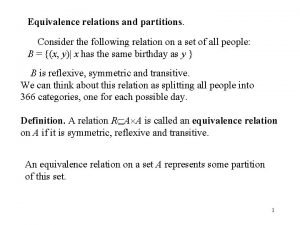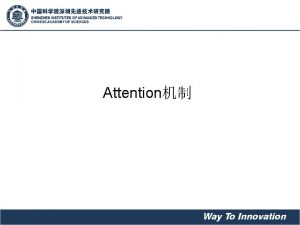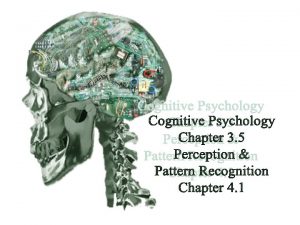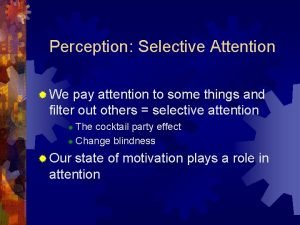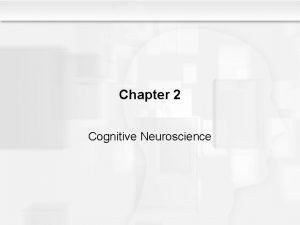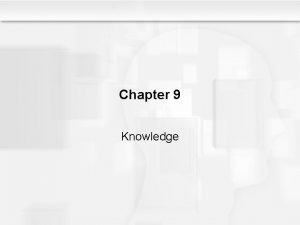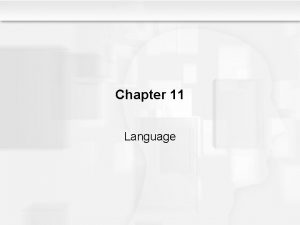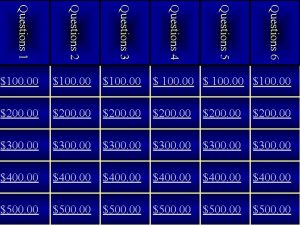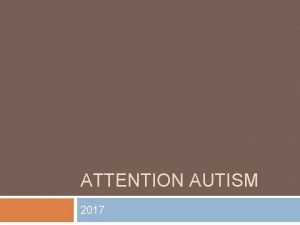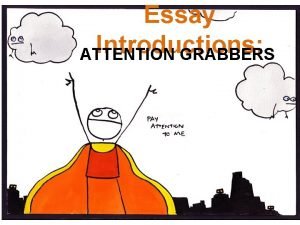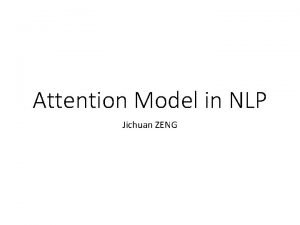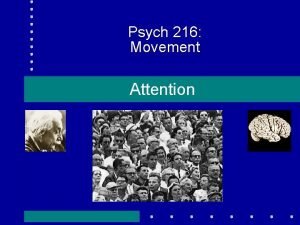Chapter 4 Attention Some Questions to Consider Is








































































- Slides: 72

Chapter 4 Attention

Some Questions to Consider • Is it possible to focus attention on just one • • • thing, even when lots of other things are going on at the same time? Under what conditions can we pay attention to more than one thing at a time? What does attention research tell us about the effect of talking on cell phones while driving a car? Is it true that we are not paying attention to a large fraction of the things happening in our environment?

Attention • Process of concentrating on specific features of the environment or on certain thoughts or activities – Selective: excluding of other features of the environment – Limited: in capacity and timing – Both overt and covert: we can consciously attend to information but some information grabs our attention

Selective Attention • Ability to focus on one message and ignore all • • others We do not attend to a large fraction of the information in the environment Filtering out some information and promoting other information for further processing

Research Method: Dichotic Listening • One message is presented to the left ear and • • another to the right ear Participant “shadows” one message to ensure he is attending to that message Can we completely filter out the message to the unattended ear and attend only to the shadowed message?

Caption: In the shadowing procedure, a person repeats out loud words he has just heard.

Results of Dichotic Listening • Participants could not report the content of the message in unattended ear – Knew that there was a message – Knew the gender of the speaker • However unattended ear is being processed at some level – Cocktail party effect – Change in gender is noticed – Change to a tone is noticed

Models of Selective Attention • Where does the attention filter occur? – Early in processing – Later in processing • Early selection model – Broadbent’s filter model • Intermediate selection model – Tresiman’s attenuation theory • Late selection model – e. g. Mc. Kay (1973)

Broadbent’s Filter Model • Early-selection model – Filters message before incoming information is analyzed for meaning Caption: Flow diagram of Broadbent’s filter model of attention.

Broadbent’s Filter Model • Sensory memory – Holds all incoming information for a fraction of a second – Transfers all information to next stage

Broadbent’s Filter Model • Filter – Identifies attended message based on physical characteristics – Only attended message is passed on to the next stage • Detector – Processes all information to determine higher-level characteristics of the message

Broadbent’s Filter Model • Short-term memory – Receives output of detector – Holds information for 10 -15 seconds and may transfer it to long-term memory

Broadbent’s Model Could Not Explain • Participant’s name gets through – Cocktail party phenomenon • Participants can shadow meaningful messages that switch from one ear to another – Dear Aunt Jane (Gray & Weddeburn, 1960) • Effects of practice on detecting information in unattended ear – You can be trained to detect in unattended ear – Based on the meaning of the message

Tresiman’s Attenuation Theory • Intermediate-selection model – Attended message can be separated from unattended message early in the informationprocessing system – Selection can also occur later Caption: Flow diagram for Treisman’s attenuation model of selective attention.

Treisman’s Attenuation Theory • Attenuator – Analyzes incoming message in terms of physical characteristics, language, and meaning • Attended to message is let through the • attenuator at full strength Unattended message is let through at a much weaker strength

Treisman’s Attenuation Theory • Dictionary unit – Contains words, each of which have thresholds for being activated • Words that are common or important have low • thresholds Uncommon words have high thresholds

Caption: The dictionary unit of Treisman’s model contains words, each of which has a threshold for being detected. This graph shows the thresholds that might exist for three words. The person’s name has a low threshold, so it will be easily detected. The thresholds for the words rutabaga and boat are higher, because they are used less or are less important to this particular listener.

Late Selection Models • Selection of stimuli for final processing does not occur until after information has been analyzed for meaning

Late Selection Models • Mc. Kay (1973) – In attending ear, participants heard ambiguous sentences • “They were throwing stones at the bank. ” – In unattended ear, participants heard either • “river” • “money”

Late Selection Models • Mc. Kay (1973) – In test, participants had to choose which was closest to the meaning of attended to message: • They threw stones toward the side of the river • yesterday They threw stones at the savings and loan association yesterday

Late Selection Models • Mc. Kay (1973) – The meaning of the biasing word affected participants’ choice – Participants were unaware of the presentation of the biasing words

Task Load and Selective Attention? • Task load: how much of a person’s cognitive resources are used to accomplish a task – High-load: uses almost all; no resources for other tasks – Low-load: uses few; resources for other tasks

Caption: Flanker-compatibility task. (a) Display in which the small square is the target, and the large square on the right is the distractor. This distractor is “compatible” because it is the same as the target. (b) Display in which the distractor is “incompatible” because it is different from the target. (c) Results of Green and Bevelier’s (2003) experiment, which found that the reaction time to indicate the presence of a target is longer for the incompatible distractor (bar I) than for the compatible distractor (bar C).

Flanker-Compatibility Task • Can participants focus their attention on detecting the target so that the identity of the distractor will not affect their performance?

Flanker-Compatibility Task • Low-load condition: one potential target – Reaction time is longer for incompatible distractors – Participant still had resources available to process additional information

Caption: Stimuli for the flanker-compatibility task in which the load is increased by adding additional stimuli to the display. The target is still the square, as in figure 4. 10, so the distractor is compatible in (a) and incompatible in (b). The results, shown in (c), indicate that under this highload condition, the reaction times are the same for both compatible and incompatible distractors. (From Green & Bevelier, 2003).

Flanker-Compatibility Task • High-load condition: type of distractor does not affect reaction time – Participants use all resources – No resources to process the distractor

Video-Game Experts • Low load: experts’ performance is similar to • non-experts High load: experts still had enough resources left to process distractors – Performance transferable to flanker-compatibility task

Effect of Load on Selective Attention • High-load experiments support early selection • Low-load experiments support late selection

Divided Attention • Practice enables people to simultaneously do two things that were difficult at first – Spelke et al. (1976) • After hours of practice, participants could read and categorize dictated words

Divided Attention • Schneider and Shiffrin (1977) – Divide attention between remembering target and monitoring rapidly presented stimuli • Memory set: 1 -4 target characters • Test frames: could contain random dot patterns, a target, distractors

Caption: Consistent mapping condition for Schneider and Shiffrin’s (1977) experiment.

Caption: Improvement in performance with practice in Schneider and Schiffrin’s (1977) experiment. The arrow indicates the point at which participants reported that the task had become automatic. This is the result of experiments in which there were four target stimuli in the memory set and two stimuli in each frame.

Divided Attention • Consistent mapping condition: target would be numbers, and distractors would be letters • Over time, participants became able to divide their attention • Automatic processing occurs without intention and only uses some of a person’s cognitive resources

Divided Attention • Stroop effect – Name of the word interferes with the ability to name the ink color – Cannot avoid paying attention to the meanings of the words

Caption: Varied mapping condition for Schneider and Shiffrin’s (1977) experiment. This is more difficult than the consistent mapping condition because all the characters are letters and also because a character that was a distractor on one trial (like the T) can become a target on another trial, and a character that was in the memory set on one trial (like the P) can become a distractor on another trial.

Divided Attention • Schneider and Shiffrin (1977) – Varied mapping condition: rules changed from trial to trail – Over time, participants never achieved automatic processing

Divided Attention • Controlled processing: participants paid close attention, and their search was slow and controlled

Caption: Comparing performance on the consistent and varied mapping tasks. Note that the horizontal axis indicates the duration of each target frame. These graphs show that frames must be presented for longer durations to achieve good performance in the varied mapping condition.

Divided Attention • 100 -car naturalistic driving study – Video recorders placed in cars – Risk of accident is four times higher when using a cell phone

Divided Attention • Strayer and Johnston (2001) – Simulated driving task – Participants on cell phone missed twice as many red lights and took longer to apply the brakes • Same result using “hands-free” cell phone

Attention and Visual Perception • Inattentional blindness: a stimulus that is not attended is not perceived, even though a person might be looking directly at it

Caption: Inattentional blindness experiment. (a) On each trial, participants judge whether the horizontal or vertical arm is longer. (b) After a few trials, the inattention trial occurs, in which a geometric object is flashed along with the arms. (c) In the recognition test, the participant is asked to indicate which geometric object was presented.

Attention and Visual Perception • Change blindness: if shown two versions of a picture, differences between them are not immediately apparent – Task to identify differences requires concentrated attention and search

Caption: Frames from the video shown in the Levin and Simons’ (1997) experiment. Note that the woman on the right is wearing a scarf around her neck in shots A, C, and D, but not in shot B. Also, the color of the plates changes from red in the first three frames to white in frame D, and the hand position of the woman on the left changes between shots C and D.

Overt Attention • Eye movements, attention, and perception – Saccades: rapid movements of the eyes from one place to another – Fixations: short pauses on points of interest – Studied by using an eye tracker

Bottom-up Determinants of Eye Movement • Stimulus salience: areas that stand out and capture attention – Bottom-up process – Depends on characteristics of the stimulus – Color and motion are highly salient

Top-Down Determinants of Eye Movements • Scene schema: knowledge about what is contained in typical scenes – Help guide fixations from one area of a scene to another • Eyes movements are determined by task – Eyes movements preceded motor actions by a fraction of a second

Caption: Sequence of fixations of a person making a peanut butter sandwich. The first fixation is on the loaf of bread.

Covert Attention: Attention without Eye Movements • Precueing: directing attention without moving the eyes – Participants respond faster to a light at an expected location than at an unexpected location – Even when eyes kept fixed

Caption: Procedure for (a) valid trials and (b) invalid trials in Posner et al. ’s (1978) precueing experiment; (c) the results of the experiment. The average reaction time was 245 ms for valid trials but 305 ms for invalid trials.

Object-Based Visual Attention • Location-based: moving attention from one place to another • Object-based: attention being directed to one place on an object

Object-Based Visual Attention • Egly et al. (1994) – Participants saw two side-by-side rectangles, followed by a target cue – Reaction time fastest when target appeared where indicated – Reaction time was faster when the target appeared in the same rectangle

Object-Based Visual Attention • The enhancing effect of attention spreads • throughout the object Attention can be based on the – Environment • static scenes or scenes with few objects – Specific object • dynamic events

Caption: Steps in Treisman’s feature integration theory. Objects are analyzed into their features in the preattentive stage, and then the features are combined later with the aid of attention.

Feature Integration Theory (FIT) • Preattentive stage – – Automatic No effort or attention Unaware of process Object analyzed into features

Feature Integration Theory (FIT) • Treisman and Schmidt (1982) – Participants report combination of features from different stimuli – Illusory conjunctions occur because features are “free floating”

Caption: Stimuli for illusory conjunction

Feature Integration Theory (FIT) • Focused attention stage – Attention plays key role – Features are combined

Feature Integration Theory (FIT) • Treisman and Schmidt (1982) – Ignore black numbers and focus on objects – Participants can correctly pair shapes and colors

Feature Integration Theory (FIT) • R. M. : Patient with Balint’s syndrome – Inability to focus attention on individual objects – High number of illusory conjunctions reported

Feature Integration Theory (FIT) • Mostly bottom-up processing • Top-down processing influences processing when participants are told what they would see – Top-down processing combines with feature analysis to help one perceive things accurately

Physiology of Attention • Attention enhances neural responding • Attentional processing is distributed across a large number of areas in the brain

Physiology of Covert Attention • Monkey trained to fixate eyes on a dot while a peripheral light was flashed – Fixation only: monkey was to release bar when the fixation light dimmed – Fixation and attention: monkey was to release bar when peripheral dimmed

Caption: Top: Stimuli for Colby et al. ’s (1995) selective attention experiment. The monkey always looked at the fixation light. A peripheral stimulus light was flashed inside the circle on the right. Below: (a) Nerve firing when the monkey was looking at the fixation light but was not paying attention to the peripheral light; (b) firing when the monkey was looking at the fixation light and paying attention to the peripheral stimulus light.

Physiology of Covert Attention • Single cell recordings showed monkey’s response when paying attention to the peripheral light was not caused by changes of the stimulus on the retina but by the monkey’s attention to light

Attention Processing Distributed Across the Cortex • Using f. MRI to detect cortical activity during a • search task Attention to an expected direction of motion caused brain activity to increase in a number of brain areas

Caption: The results of Schulman and coworkers’ (1999) experiment, showing some of the brain areas activated by viewing the moving dots. The graphs indicate the amount of brain activity when participants were cued to pay attention to a particular direction of movement (red lines) and when they were cued to just passively view the moving dots (green lines).

Attention in Social Situations: Autism • Autism: serious developmental disorder in which one of the major symptoms is the withdrawal of contact from other people

Attention in Social Situations: Autism • Can solve reasoning problems that involve social situations • Cannot function when placed in an actual social situation • This may be due to the way those with autism observe what is happening

Attention in Social Situations: Autism • Non-autistic observers look to eyes to assess emotional reaction • Autistic observers look to the mouth or off to the side of the face to assess emotional reaction

Attention in Social Situations: Autism • Autistic people’s attention (or lack thereof) may be one way in which they see things differently in the environment
 Michelle benjamin phd
Michelle benjamin phd They say it only takes a little faith to move a mountain
They say it only takes a little faith to move a mountain They say sometimes you win some
They say sometimes you win some Cake countable or uncountable
Cake countable or uncountable Contact force
Contact force Fire and ice diamante poem
Fire and ice diamante poem Some say the world will end in fire some say in ice
Some say the world will end in fire some say in ice Some trust in horses
Some trust in horses Any question thank you
Any question thank you Natasha tried holding her breath
Natasha tried holding her breath Faith like job
Faith like job Consider a person standing in a breezy room at 20
Consider a person standing in a breezy room at 20 Consider all relevant criteria
Consider all relevant criteria Verb infinitive
Verb infinitive Labour saving devices in the kitchen and their uses
Labour saving devices in the kitchen and their uses Consider transferring an enormous file of l
Consider transferring an enormous file of l Consider christ
Consider christ Consider all factors example
Consider all factors example Factors to consider when making an investment
Factors to consider when making an investment An interview with shakespeare study guide
An interview with shakespeare study guide Prefix of consider
Prefix of consider Explain factors to consider when proposing dishes for menus
Explain factors to consider when proposing dishes for menus Consider a u-tube whose arms are open
Consider a u-tube whose arms are open Consider the balance of a commercial bank
Consider the balance of a commercial bank Elegy o captain my captain
Elegy o captain my captain Multinational capital budgeting
Multinational capital budgeting When did bagchi's mother die ?
When did bagchi's mother die ? Distance between pixels is called
Distance between pixels is called What do you consider your greatest strengths and weaknesses
What do you consider your greatest strengths and weaknesses Consider the market for cheese-stuffed jalapeno peppers
Consider the market for cheese-stuffed jalapeno peppers Decomposition of caco3
Decomposition of caco3 I said she might consider a new haircut
I said she might consider a new haircut Milton when i consider
Milton when i consider Consider two edge dislocations of opposite sign
Consider two edge dislocations of opposite sign Consider a mach 4 airflow at a pressure of 1 atm. we wish
Consider a mach 4 airflow at a pressure of 1 atm. we wish Consider n pairs of numbers
Consider n pairs of numbers Consider simple past
Consider simple past Consider the following three classes
Consider the following three classes Huff's law of shopper attraction
Huff's law of shopper attraction The apt requires a benchmark portfolio
The apt requires a benchmark portfolio Consider all factors de bono
Consider all factors de bono Consider a case of a two-component standby system
Consider a case of a two-component standby system The rivals by sheridan summary
The rivals by sheridan summary Consider a football coach pacing back and forth
Consider a football coach pacing back and forth Important factors when designing a menu
Important factors when designing a menu Consider the augmented grammar
Consider the augmented grammar Consider all angles
Consider all angles Consider the following snapshot of a system
Consider the following snapshot of a system Circular functions
Circular functions Icebreaker about failure
Icebreaker about failure Miss 2. ve 3. hali
Miss 2. ve 3. hali Consider o o
Consider o o Page table
Page table Consider the following three classes
Consider the following three classes Captive-product pricing
Captive-product pricing Consider the following c program
Consider the following c program Consider the following c function void swap
Consider the following c function void swap What factors did you consider in acquiring territories?
What factors did you consider in acquiring territories? Cathedral city of salisbury
Cathedral city of salisbury Linear vs circular queue
Linear vs circular queue Show that the maximum efficiency of pure aloha is 1/(2e)
Show that the maximum efficiency of pure aloha is 1/(2e) Factors to consider before going global
Factors to consider before going global Dot convention mutual inductance
Dot convention mutual inductance 4.1 right triangle trigonometry
4.1 right triangle trigonometry Consider the system
Consider the system Ellipsis and substitution grammar
Ellipsis and substitution grammar Arithmetic sequence sigma notation
Arithmetic sequence sigma notation Consider it pure joy
Consider it pure joy The sum of two nonnegative numbers is 20
The sum of two nonnegative numbers is 20 Marketers need to consider the state of trading economy
Marketers need to consider the state of trading economy John milton on his blindness
John milton on his blindness Consider the following situations
Consider the following situations Consider the following relation
Consider the following relation
